While plant names assigned by botanists often seem incomprehensible or even barbaric, for this beautiful American white flower, one can only applaud the chosen name. Eucharis, meaning “true grace,” is indeed the name of a Greek nymph, the most beautiful, loved by Telemachus. The plant itself is a bulbous plant that is quite commonly seen in gardens in Laos. The very fragrant and pure white flowers, about ten centimeters in size, are gathered in umbels at the end of a tall stem. They hang towards the ground, but at their center, you can observe a green-tinted crown formed by the long stamens fused at their base. The foliage is dark green and shiny; the large leaves are drooping and pointed at the ends to allow rainwater to drain off, a common characteristic in many tropical plants.
Eucharis thrives in dark and humid tropical forests on the eastern slopes of the Andes and in the sparsely populated Amazon region. However, botanists claim that this plant, which is a hybrid, is sterile, meaning it can only be reproduced by humans. Archaeologists and ethnologists working in these regions suggest that an ancient Amerindian civilization once lived there during an unknown period. These people might have cultivated Eucharis as a magical and medicinal plant (it contains alkaloids), or, like the Aztecs, they may have had an interest in horticulture. This beautiful white flower could be one of the few remnants of a lost civilization. Pascal Vigneron, who tells this story (Iris et Bulbeuses No. 155), names it the “flower of El Dorado.”
The Laotians interviewed claim not to know the plant’s name, but some suggest van nang kwak or van nok khoun, which is also used in Thailand. As seen before, the term “van” often indicates a strong magical or medicinal plant, usually with a bulbous root. Nok khoun could refer to the bird that brings luck, and as for nang kwak, as mentioned earlier, it’s the name of a deity who beckons to passers-by with a small hand gesture. Additionally, in French, this flower is called the “lis de la vierge” (lily of the virgin), thus linking it to three feminine references: the mother of Christ, a Greek nymph, and a Laotian goddess.
As you gaze upon the flower in your garden, you might be inspired to recite these verses from a forgotten French poet (Antoine Bertin 1780):
Regardez Eucharis, vous qui craignez d’aimer,
Et vous voudrez mourir du feu qui me dévore;
Vous dont le cœur éteint ne peut plus s’enflammer;
Regardez Eucharis, vous aimerez encore.
“Look at Eucharis, you who fear to love,
And you will wish to die from the fire that consumes me;
You, whose extinguished heart can no longer ignite;
Look at Eucharis, you will love again.”
Si trop souvent les noms de plante donnés par les botanistes nous paraissent incompréhensibles, voire barbares, pour cette belle fleur blanche américaine on ne peut qu’applaudir le choix fait. Eucharis, « vraie grâce », est en effet le nom d’une nymphe grecque, belle entre toutes, aimée de Télémaque. La plante, elle, est une bulbeuse que l’on voit assez souvent dans les jardins au Laos. Très odorantes et d’un blanc très pur, les fleurs d’une dizaine de centimètres sont réunies en ombelles au bout d’une grande hampe; elles penchent vers le sol mais l’on peut voir en leur centre une couronne teintée de vert formée par les longues étamines soudées à leur base. Le feuillage est vert foncé, luisant; les grandes feuilles sont retombantes et terminées en pointe pour laisser s’écouler l’eau de pluie comme chez beaucoup de plantes tropicales.
L’Eucharis vit dans les forêts tropicales sombres et humides du versant est des Andes et dans l’Amazonie adjacente très peu peuplée. Or les botanistes disent que cette plante qui est un hybride est stérile, c’est-à-dire qu’elle n’a pu être reproduite que par l’homme. Les archéologues et les ethnologues qui travaillent dans ces régions supposent qu’une ancienne civilisation amérindienne vivait là à une époque inconnue; ces hommes auraient reproduit l’Eucharis comme plante magique et médicinale (elle contient des alcaloïdes) ou, comme les Aztèques, peut-être avaient-ils un intérêt pour l’horticulture. Cette belle fleur blanche serait ainsi l’un des rares témoignages d’une civilisation disparue et Pascal Vigneron qui nous raconte cette histoire (Iris et Bulbeuses n° 155) la baptise « fleur de l’Eldorado ».
Les Lao interrogés disent ne pas connaître le nom de la plante, mais certains hasardent van nang kwak ou van nok khoun, employé aussi en Thaïlande. On a vu à plusieurs reprises que le terme « van » indiquait une plante magique ou médicinale forte, en général avec une racine bulbeuse; « nok khoun » serait l’oiseau qui porte chance, quant à nang kwak, nous l’avons dit aussi c’est le nom d’une déité qui appelle les passants en leur faisant un petit signe de la main. Ajoutons qu’en français cette fleur se nomme « lis de la vierge »; elle est donc placée sous une triple référence féminine: la mère du Christ, une nymphe grecque et une déesse lao.
En regardant la fleur dans votre jardin vous pourrez toujours réciter ces vers d’un poète oublié (Antoine Bertin 1780) :
Regardez Eucharis, vous qui craignez d’aimer,
Et vous voudrez mourir du feu qui me dévore;
Vous dont le cœur éteint ne peut plus s’enflammer;
Regardez Eucharis, vous aimerez encore.
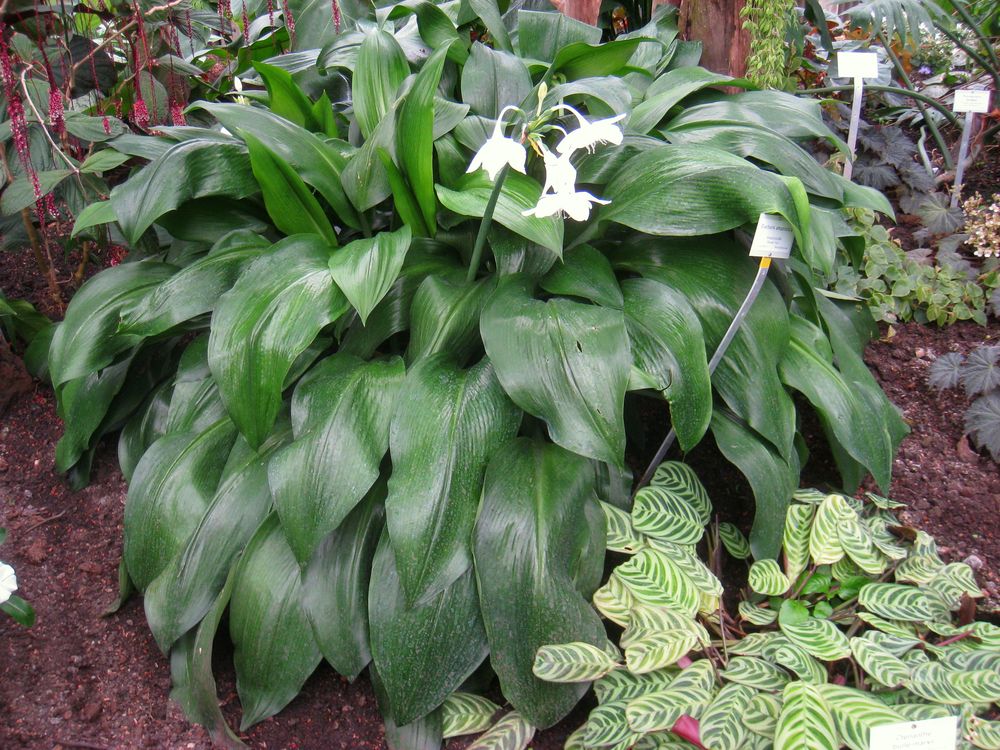
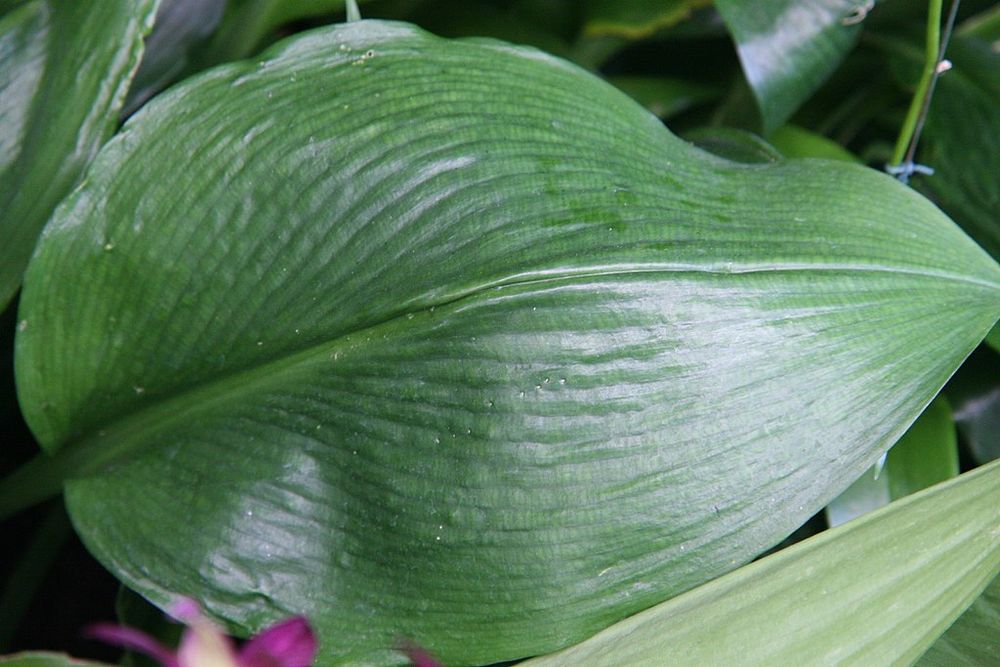
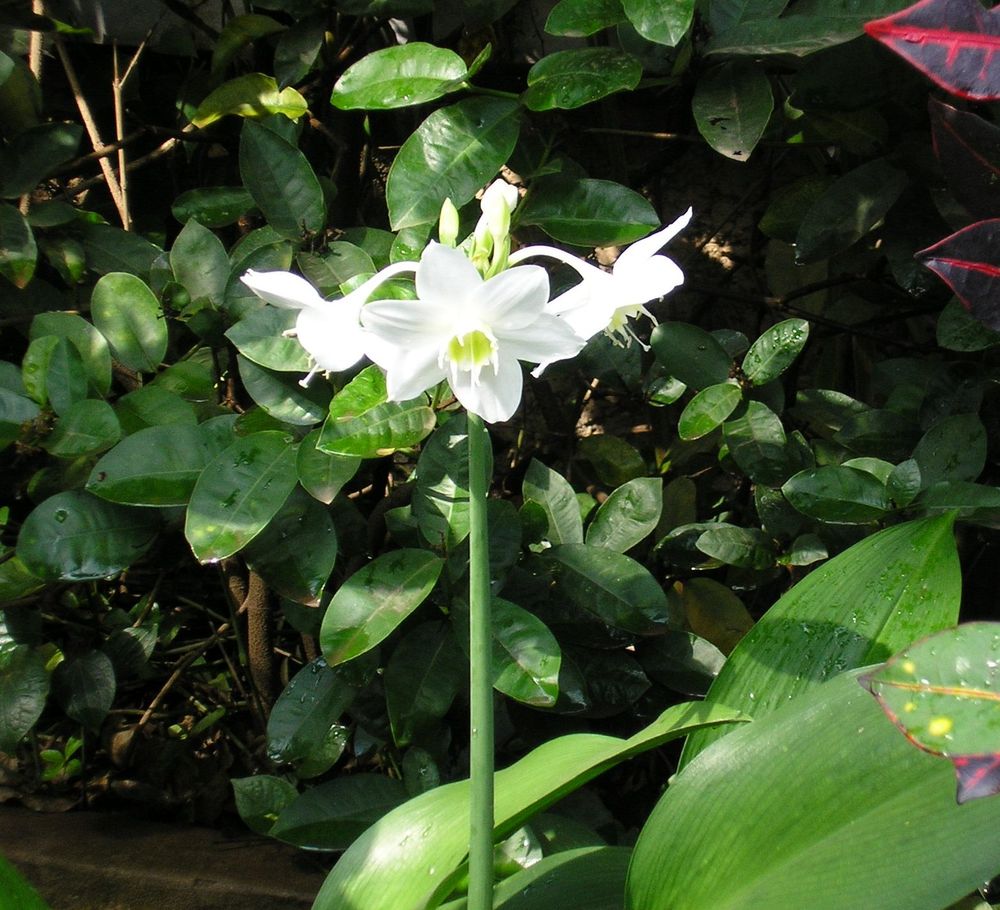
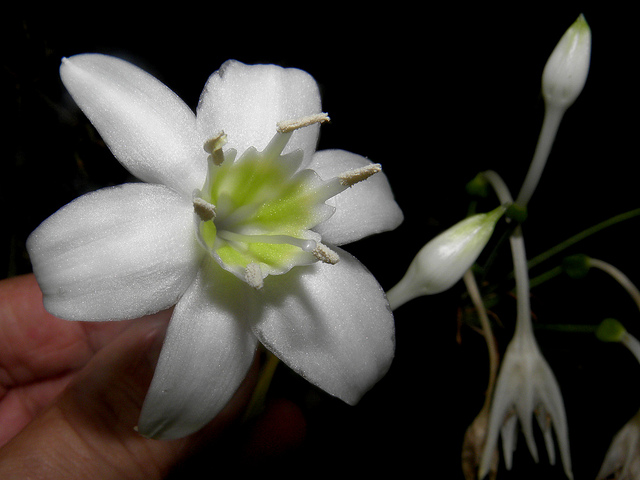
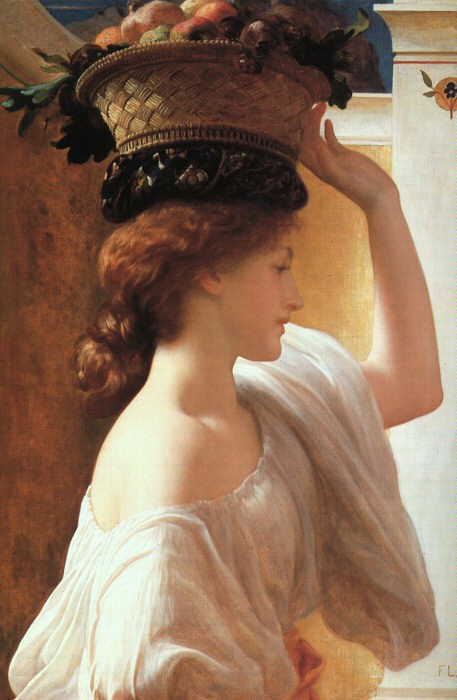
While plant names assigned by botanists often seem incomprehensible or even barbaric, for this beautiful American white flower, one can only applaud the chosen name. Eucharis, meaning “true grace,” is indeed the name of a Greek nymph, the most beautiful, loved by Telemachus. The plant itself is a bulbous plant that is quite commonly seen in gardens in Laos. The very fragrant and pure white flowers, about ten centimeters in size, are gathered in umbels at the end of a tall stem. They hang towards the ground, but at their center, you can observe a green-tinted crown formed by the long stamens fused at their base. The foliage is dark green and shiny; the large leaves are drooping and pointed at the ends to allow rainwater to drain off, a common characteristic in many tropical plants.
Eucharis thrives in dark and humid tropical forests on the eastern slopes of the Andes and in the sparsely populated Amazon region. However, botanists claim that this plant, which is a hybrid, is sterile, meaning it can only be reproduced by humans. Archaeologists and ethnologists working in these regions suggest that an ancient Amerindian civilization once lived there during an unknown period. These people might have cultivated Eucharis as a magical and medicinal plant (it contains alkaloids), or, like the Aztecs, they may have had an interest in horticulture. This beautiful white flower could be one of the few remnants of a lost civilization. Pascal Vigneron, who tells this story (Iris et Bulbeuses No. 155), names it the “flower of El Dorado.”
The Laotians interviewed claim not to know the plant’s name, but some suggest van nang kwak or van nok khoun, which is also used in Thailand. As seen before, the term “van” often indicates a strong magical or medicinal plant, usually with a bulbous root. Nok khoun could refer to the bird that brings luck, and as for nang kwak, as mentioned earlier, it’s the name of a deity who beckons to passers-by with a small hand gesture. Additionally, in French, this flower is called the “lis de la vierge” (lily of the virgin), thus linking it to three feminine references: the mother of Christ, a Greek nymph, and a Laotian goddess.
As you gaze upon the flower in your garden, you might be inspired to recite these verses from a forgotten French poet (Antoine Bertin 1780):
Regardez Eucharis, vous qui craignez d’aimer,
Et vous voudrez mourir du feu qui me dévore;
Vous dont le cœur éteint ne peut plus s’enflammer;
Regardez Eucharis, vous aimerez encore.
“Look at Eucharis, you who fear to love,
And you will wish to die from the fire that consumes me;
You, whose extinguished heart can no longer ignite;
Look at Eucharis, you will love again.”
Si trop souvent les noms de plante donnés par les botanistes nous paraissent incompréhensibles, voire barbares, pour cette belle fleur blanche américaine on ne peut qu’applaudir le choix fait. Eucharis, « vraie grâce », est en effet le nom d’une nymphe grecque, belle entre toutes, aimée de Télémaque. La plante, elle, est une bulbeuse que l’on voit assez souvent dans les jardins au Laos. Très odorantes et d’un blanc très pur, les fleurs d’une dizaine de centimètres sont réunies en ombelles au bout d’une grande hampe; elles penchent vers le sol mais l’on peut voir en leur centre une couronne teintée de vert formée par les longues étamines soudées à leur base. Le feuillage est vert foncé, luisant; les grandes feuilles sont retombantes et terminées en pointe pour laisser s’écouler l’eau de pluie comme chez beaucoup de plantes tropicales.
L’Eucharis vit dans les forêts tropicales sombres et humides du versant est des Andes et dans l’Amazonie adjacente très peu peuplée. Or les botanistes disent que cette plante qui est un hybride est stérile, c’est-à-dire qu’elle n’a pu être reproduite que par l’homme. Les archéologues et les ethnologues qui travaillent dans ces régions supposent qu’une ancienne civilisation amérindienne vivait là à une époque inconnue; ces hommes auraient reproduit l’Eucharis comme plante magique et médicinale (elle contient des alcaloïdes) ou, comme les Aztèques, peut-être avaient-ils un intérêt pour l’horticulture. Cette belle fleur blanche serait ainsi l’un des rares témoignages d’une civilisation disparue et Pascal Vigneron qui nous raconte cette histoire (Iris et Bulbeuses n° 155) la baptise « fleur de l’Eldorado ».
Les Lao interrogés disent ne pas connaître le nom de la plante, mais certains hasardent van nang kwak ou van nok khoun, employé aussi en Thaïlande. On a vu à plusieurs reprises que le terme « van » indiquait une plante magique ou médicinale forte, en général avec une racine bulbeuse; « nok khoun » serait l’oiseau qui porte chance, quant à nang kwak, nous l’avons dit aussi c’est le nom d’une déité qui appelle les passants en leur faisant un petit signe de la main. Ajoutons qu’en français cette fleur se nomme « lis de la vierge »; elle est donc placée sous une triple référence féminine: la mère du Christ, une nymphe grecque et une déesse lao.
En regardant la fleur dans votre jardin vous pourrez toujours réciter ces vers d’un poète oublié (Antoine Bertin 1780) :
Regardez Eucharis, vous qui craignez d’aimer,
Et vous voudrez mourir du feu qui me dévore;
Vous dont le cœur éteint ne peut plus s’enflammer;
Regardez Eucharis, vous aimerez encore.










While plant names assigned by botanists often seem incomprehensible or even barbaric, for this beautiful American white flower, one can only applaud the chosen name. Eucharis, meaning “true grace,” is indeed the name of a Greek nymph, the most beautiful, loved by Telemachus. The plant itself is a bulbous plant that is quite commonly seen in gardens in Laos. The very fragrant and pure white flowers, about ten centimeters in size, are gathered in umbels at the end of a tall stem. They hang towards the ground, but at their center, you can observe a green-tinted crown formed by the long stamens fused at their base. The foliage is dark green and shiny; the large leaves are drooping and pointed at the ends to allow rainwater to drain off, a common characteristic in many tropical plants.
Eucharis thrives in dark and humid tropical forests on the eastern slopes of the Andes and in the sparsely populated Amazon region. However, botanists claim that this plant, which is a hybrid, is sterile, meaning it can only be reproduced by humans. Archaeologists and ethnologists working in these regions suggest that an ancient Amerindian civilization once lived there during an unknown period. These people might have cultivated Eucharis as a magical and medicinal plant (it contains alkaloids), or, like the Aztecs, they may have had an interest in horticulture. This beautiful white flower could be one of the few remnants of a lost civilization. Pascal Vigneron, who tells this story (Iris et Bulbeuses No. 155), names it the “flower of El Dorado.”
The Laotians interviewed claim not to know the plant’s name, but some suggest van nang kwak or van nok khoun, which is also used in Thailand. As seen before, the term “van” often indicates a strong magical or medicinal plant, usually with a bulbous root. Nok khoun could refer to the bird that brings luck, and as for nang kwak, as mentioned earlier, it’s the name of a deity who beckons to passers-by with a small hand gesture. Additionally, in French, this flower is called the “lis de la vierge” (lily of the virgin), thus linking it to three feminine references: the mother of Christ, a Greek nymph, and a Laotian goddess.
As you gaze upon the flower in your garden, you might be inspired to recite these verses from a forgotten French poet (Antoine Bertin 1780):
Regardez Eucharis, vous qui craignez d’aimer,
Et vous voudrez mourir du feu qui me dévore;
Vous dont le cœur éteint ne peut plus s’enflammer;
Regardez Eucharis, vous aimerez encore.
“Look at Eucharis, you who fear to love,
And you will wish to die from the fire that consumes me;
You, whose extinguished heart can no longer ignite;
Look at Eucharis, you will love again.”
Si trop souvent les noms de plante donnés par les botanistes nous paraissent incompréhensibles, voire barbares, pour cette belle fleur blanche américaine on ne peut qu’applaudir le choix fait. Eucharis, « vraie grâce », est en effet le nom d’une nymphe grecque, belle entre toutes, aimée de Télémaque. La plante, elle, est une bulbeuse que l’on voit assez souvent dans les jardins au Laos. Très odorantes et d’un blanc très pur, les fleurs d’une dizaine de centimètres sont réunies en ombelles au bout d’une grande hampe; elles penchent vers le sol mais l’on peut voir en leur centre une couronne teintée de vert formée par les longues étamines soudées à leur base. Le feuillage est vert foncé, luisant; les grandes feuilles sont retombantes et terminées en pointe pour laisser s’écouler l’eau de pluie comme chez beaucoup de plantes tropicales.
L’Eucharis vit dans les forêts tropicales sombres et humides du versant est des Andes et dans l’Amazonie adjacente très peu peuplée. Or les botanistes disent que cette plante qui est un hybride est stérile, c’est-à-dire qu’elle n’a pu être reproduite que par l’homme. Les archéologues et les ethnologues qui travaillent dans ces régions supposent qu’une ancienne civilisation amérindienne vivait là à une époque inconnue; ces hommes auraient reproduit l’Eucharis comme plante magique et médicinale (elle contient des alcaloïdes) ou, comme les Aztèques, peut-être avaient-ils un intérêt pour l’horticulture. Cette belle fleur blanche serait ainsi l’un des rares témoignages d’une civilisation disparue et Pascal Vigneron qui nous raconte cette histoire (Iris et Bulbeuses n° 155) la baptise « fleur de l’Eldorado ».
Les Lao interrogés disent ne pas connaître le nom de la plante, mais certains hasardent van nang kwak ou van nok khoun, employé aussi en Thaïlande. On a vu à plusieurs reprises que le terme « van » indiquait une plante magique ou médicinale forte, en général avec une racine bulbeuse; « nok khoun » serait l’oiseau qui porte chance, quant à nang kwak, nous l’avons dit aussi c’est le nom d’une déité qui appelle les passants en leur faisant un petit signe de la main. Ajoutons qu’en français cette fleur se nomme « lis de la vierge »; elle est donc placée sous une triple référence féminine: la mère du Christ, une nymphe grecque et une déesse lao.
En regardant la fleur dans votre jardin vous pourrez toujours réciter ces vers d’un poète oublié (Antoine Bertin 1780) :
Regardez Eucharis, vous qui craignez d’aimer,
Et vous voudrez mourir du feu qui me dévore;
Vous dont le cœur éteint ne peut plus s’enflammer;
Regardez Eucharis, vous aimerez encore.


